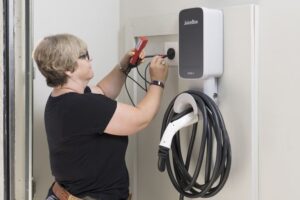Battery float charging is a crucial aspect of maintaining the longevity and performance of your batteries. So, what exactly is battery float charging? Simply put, it is a method of charging your batteries at a constant voltage, once they have reached their full capacity. This technique ensures that your batteries remain fully charged without overcharging, preventing damage and maximizing their lifespan. In this article, we will delve into the details of battery float charging, its benefits, and how it can optimize the performance of your batteries. Let’s dive in!
What Is Battery Float Charging?
Battery float charging is a technique used to maintain the charge of a battery at a specific level without overcharging it. It is commonly used in applications where batteries need to be kept in a ready-to-use state for extended periods of time. Float charging helps to prevent self-discharge and maintain battery capacity, ensuring that the battery is always in optimal condition when needed.
How Does Float Charging Work?
Float charging operates by applying a constant voltage to the battery that matches its self-discharge rate. When a battery is not in use, it tends to lose its charge over time due to internal chemical reactions. Float charging compensates for this by providing a continuous low-level charge to counteract the self-discharge. The voltage applied during float charging is typically set slightly higher than the battery’s fully charged voltage, but below the level that would cause overcharging.
During float charging, the battery remains connected to a power source, such as a charger or a power supply. The charging voltage is carefully regulated to prevent the battery from being overcharged. This ensures that the battery maintains its charge level without damaging its internal components.
Benefits of Battery Float Charging
Float charging offers several benefits, making it an essential technique for various applications. Some of the key advantages include:
- Battery Maintenance: Float charging helps to enhance the lifespan of batteries by preventing self-discharge and reducing the risk of sulfation, which can occur when batteries are left without a charge for extended periods. By maintaining a proper charge level, float charging ensures that batteries are always ready for use.
- Cost Savings: By prolonging battery life, float charging reduces the frequency of battery replacements, resulting in cost savings over time. It is particularly advantageous for applications that require a large number of batteries, such as telecommunications, uninterruptible power supply (UPS) systems, and emergency backup systems.
- Reliability: Float charging helps to ensure the reliability of battery-powered devices or systems. By constantly providing a small charge, it minimizes the risk of power failure due to discharged batteries. This makes it ideal for critical applications where uninterrupted power supply is vital.
- Convenience: Battery float charging eliminates the need for manual intervention to recharge batteries regularly. Once the float charging system is properly set up, it can operate automatically, saving time and effort.
- Increased Battery Capacity: Float charging can increase the effective capacity of a battery by reducing the rate of self-discharge. This ensures that the battery retains a higher charge for longer periods, making it more reliable when needed.
- Prevention of Battery Damage: Overcharging is detrimental to battery health and can lead to reduced capacity, shortened lifespan, and even safety hazards. Float charging prevents overcharging by maintaining a steady voltage within safe limits, protecting the battery from damage.
Applications of Battery Float Charging
Battery float charging finds applications in various industries and scenarios where maintaining battery performance and reliability are crucial. Some common applications include:
Telecommunications
In the telecommunications industry, batteries play a critical role in providing backup power for communication towers, equipment, and uninterrupted services. Float charging ensures that the backup batteries remain fully charged, ready to kick in during power outages or emergencies. It helps to avoid service disruptions and enables seamless communication even during extended power failures.
Uninterruptible Power Supply (UPS) Systems
UPS systems are essential for protecting critical equipment and data centers from power interruptions or outages. Float charging is employed in UPS systems to keep the backup batteries at optimal charge levels. This ensures that the UPS can provide uninterrupted power to safeguard sensitive equipment, such as servers, routers, and essential infrastructure.
Emergency Backup Systems
Float charging is commonly used in emergency backup systems, such as emergency lighting, fire alarms, and security systems. These systems rely on batteries to provide immediate power in emergencies. Float charging ensures that the backup batteries are ready to perform when needed, minimizing any potential risks or hazards associated with power failures.
Solar Power Systems
Solar power systems often incorporate battery storage to store excess energy generated by the solar panels for later use. Float charging is employed to maintain the charge of these batteries and ensure they are always ready to provide power when the demand exceeds the solar panel output. It helps to maximize the overall efficiency and reliability of the solar power system.
Marine and RV Applications
Float charging is used in marine and RV applications where battery-powered systems, such as marine electronics or onboard appliances, need to be kept in optimal condition. Float charging helps to prevent battery discharge when the systems are not in use, ensuring they are ready for operation when needed.
Electric Vehicles
Electric vehicles (EVs) rely on batteries for their power source. Float charging is utilized in EVs to maintain the charge of the battery pack when the vehicle is not in use. This helps to preserve the battery capacity, maximize the driving range, and ensure the vehicle is always ready for use.
Choosing the Right Float Charging System
When selecting a float charging system, there are several factors to consider to ensure optimal performance and battery health. These include:
Float Voltage and Current
The float voltage refers to the constant voltage applied to the battery during float charging. It should be set based on the battery manufacturer’s recommendations to avoid overcharging or undercharging. The float current refers to the amount of current supplied to the battery during float charging. It should be sufficient to compensate for the self-discharge rate of the battery.
Charger Quality and Compatibility
The quality of the float charger is crucial for maintaining optimal battery performance. Choosing a high-quality charger specifically designed for float charging ensures proper regulation of voltage and current, preventing overcharging or damage to the battery. Additionally, compatibility with the battery type and capacity is essential for efficient charging.
Battery Temperature Compensation
Battery capacity and charging characteristics can vary with temperature. Float charging systems with temperature compensation capabilities adjust the charging parameters based on the battery temperature to ensure optimal charging and avoid overcharging or undercharging.
Battery Monitoring and Maintenance
Some float charging systems offer built-in battery monitoring and maintenance features. These may include automatic discharge testing, desulfation modes, or periodic equalization charging. These additional functions can help prolong battery life and maintain optimal performance.
Battery float charging is a valuable technique for maintaining the performance and reliability of batteries over extended periods. It helps to prevent self-discharge, preserve battery capacity, and ensure readiness for critical applications. By implementing float charging in various industries and scenarios, businesses can reduce costs, enhance reliability, and prolong battery lifespan. Choosing the right float charging system and adhering to manufacturer guidelines are essential for achieving optimal results and maximizing the benefits of this charging method.
Frequently Asked Questions
What is battery float charging?
Battery float charging is a process in which a battery is constantly maintained at its full charge level, preventing it from overcharging or discharging. It involves applying a constant voltage to the battery to compensate for any self-discharge and keep it ready for immediate use.
How does battery float charging work?
Battery float chargers typically provide a low, consistent voltage to the battery, usually around 2.25 to 2.30 volts per cell for lead-acid batteries. This voltage is lower than the typical charging voltage, ensuring that the battery is not subjected to excessive or aggressive charging. By maintaining a lower voltage, the battery remains in a fully charged state without the risk of overcharging.
Why is battery float charging important?
Battery float charging plays a vital role in prolonging the lifespan of batteries. It prevents them from experiencing deep discharge cycles, which can lead to irreversible damage. By keeping batteries in a fully charged condition, float charging ensures that they are always ready for use and extends their overall service life.
Where is battery float charging commonly used?
Battery float charging is commonly used in various applications that require the continuous availability of power, such as uninterruptible power supply (UPS) systems, emergency lighting, security systems, and telecommunications equipment. It is also utilized in vehicles, boats, and RVs to maintain battery health during periods of inactivity.
Can any type of battery be float charged?
Not all battery types are suitable for float charging. Lead-acid batteries, including both flooded and sealed types, are commonly float charged. Other battery chemistries like lithium-ion batteries have specific charging requirements and should not undergo float charging as it can lead to overcharging and damage.
What precautions should be taken during battery float charging?
When performing battery float charging, it is essential to use a charger specifically designed for this purpose to ensure proper voltage regulation. Additionally, regular monitoring of battery temperature and electrolyte levels for flooded batteries is recommended to prevent any potential issues. It is also important to follow the manufacturer’s guidelines and recommendations for the specific battery being charged.
Final Thoughts
Battery float charging is a crucial method to maintain the health and longevity of batteries. By supplying a continuous low voltage charge, float charging helps to counteract self-discharge and prevent sulfation, a common cause of battery failure. It ensures that the battery remains fully charged without overcharging, resulting in optimal performance and extended lifespan. Whether in automotive, industrial, or renewable energy applications, implementing a float charging system is essential for preserving battery capacity and maximizing their reliability. So, what is battery float charging? It is the key to keeping batteries in top-notch condition and ensuring their efficient operation.



